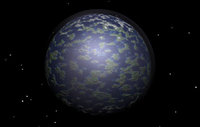Space Condominium
The Space Condominium is the fictional government occuring in the Sci-Fi series Space Voyage 2245.
History
According to the original novels, the Condominium originated in the early 21st century as the nations of Earth began founding new colonies in Space. The various nations of Earth competed with each other, each seeking the best and largest amount of territory. Numerous small wars were fought. Eventually, the tensions lead to the Martian War, fought over control of vast portions of Mars. The war spilled over to Earth itself, and resulted in widespread devestation.
The nations of Earth, and a few recognized states in Space, agreed to govern all extraterrestrial territories collectively as a Condominium (there had been some condominia previously). Though full sovreignty was preserved over their own territories, this proved the start of a gradual union of states, until by 2245, the Space Condominium has effectively become a federal government.
In 2062, the Transitional Drive was invented, allowing humanity to leave the confines of the Solar System. The Space Condominium began expanding outwards, finding new worlds and settling them (the dramatic rise in extraterrestrial population helped to ensure the domination of the Condominium over its nominal proprietors). In the early 22nd century, the first contact with alien life was discovered, and eventually they were welcomed into the Condominium as co-equal parties.
Homeworlds
Earth
Earth itself is, like other Homeworlds, nominally outside of the Condominium, though in practical terms, it is like any other part. It remains divided among many nations (with reduced sovreignty), though there have been some mergers. There was, for example, a reference to some kind of reunited China, but without any details. For the most part, however, the books tended to skim over details on Earth.
Oceanea
Oceanea is, as the name implies, covered by ocean, dotted with islands. It is the homeworld of the Aqueans. The depths of the Aquean ocean have not yet been probed, and some exoplanetologists, notably Marcus Pasquinia suspect that Aquea is actually a planet made entirely of water, held together by massive fields.
Sagittaria
The homeworld of the Sagittarians and the Ulgween, it is similar to Earth. Unlike Earth, it has no large continents, but is divided into dozens of minicontinents. The Sagittarians and the Ulgween evolved on different continents. Sagittaria is roughly 1.36 Earth masses, and has a slightly richer oxygen content than Earth. Sagittaria's biome is much less rich than Earths, and it is suspected by many exo-biologists as well as those from Sagittaria that there was some form of die-off caused by a global calamity or that Sagittaria was seeded as a form of Terraforming.
Recently, the Ulgween have been granted autonomy in local affairs, following an uprising against their perceived agressors the Sagittarians.
Tresht
Tresht is a desert world, the home of the Yrgoans. Tresht has a rotational period of 53 hours, causing the days to reach temperatures of 140F (change to IB) and the nights to drop to -40F. It was only recently that the Yrgoans have admitted that Tresht is not their homeworld. Tresht was chosen by the Yrgoans, as it was a world without frills, where they could focus on their internal logic, forgetting the world around them. While they maintain their own gardens in the deepest caves for their personal sustenance, much of their days (and nights) contemplating the desert world of Tresht.
Colonies
- Edo: A Japanese science colony in orbit of 36 Ophiuchi.
- Edenia: A tropical resort planet.
- Gascognia: A failed Francophone colony.
- Hither and Yon: Two colonies orbiting Alpha Centauri AB
- Winken, Blinken and Nod: Three colonies orbiting Groombridge 34 AB

